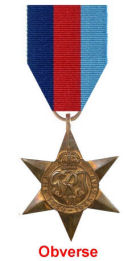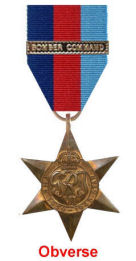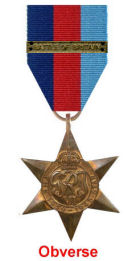THE 1939-1945 STAR
Obverse: A six pointed star, in the centre of which is the Royal Cypher surmounted by a crown superimposed on a circlet that bears the words "THE 1939-1945 STAR".
Reverse: Plain.
Size: 38mm across and 50mm from the bottom point of the star to the top of the eyelet.
Ribbon: 32mm wide. The colours of the ribbon are, reading from the left when facing the wearer, dark blue, red and light blue in equal proportions. They symbolise the Navy, the Merchant Navy, the Army and the Air Force.
Suspension: The ribbon passes through a ring which in turn passes through an eyelet formed in the uppermost point of the star.
Clasps Issued: 2
"Bomber Command" & "Battle of Britain". The "Bomber Command" clasp was instituted in 2013.
This bronze star was awarded for service in the Second World War between 3rd September, 1939, and 2nd September, 1945.
For details of the qualifications for the award, refer to the Regulations below.
GENERAL REMARKS CONCERNING THE 1939-45 CAMPAIGN STARS
(1) Service in ships making occasional visits to the scenes of operations for refueling would not necessarily be a qualification.
(2) The expression "entry into operational service" in the case of The Atlantic Star and The Air Crew Europe Star was subject to the qualification that six or two months' operational service, as applicable, must have already been rendered. For awards to the Navy and the Merchant Navy of The Pacific Star, The Burma Star and The Italy Star, a similar prior time qualification of six months also applied. There were, however, certain exceptions to these rules that have been enumerated in the applicable texts.
(3) A recipient of The 1939-45 Star who qualified for it by less than the six or two months' service respectively, had to complete the requisite period before he could begin to qualify for The Atlantic Star or The Air Crew Europe Star respectively. In the case of the Navy and Merchant Navy, the applicable qualifying period had to be completed before they could begin to qualify for The Pacific Star, The Burma Star or The Italy Star.
(4) For The Atlantic Star or The Air Crew Europe Star in the Armed Forces or Merchant Navy, or for The Pacific Star, The Burma Star or The Italy Star in the Navy or Merchant Navy, operational service for a lesser period than six or two months as the case may be, which was brought to an end by death, wounds or other disability due to service, or, alternatively, the grant for service in operations of an Honour, Decoration, Mention in Dispatches, King's Commendation for Brave Conduct or King's Commendation for Valuable Service in the Air, was a qualification for award, without regard for the prior service requirement. The restrictions concerning the alternative awards of stars still applied.
(5) Time spent as a prisoner of war would count towards The 1939-45 Star, but it would not count towards earning any of the other stars unless the full qualifying period of The 1939-45 Star had been completed before capture. If, however, the candidate had completed his requisite qualifying period for The 1939-45 Star and was captured during the period he was qualifying for one of the other stars, then the period spent in captivity would count. In the case of the Merchant Navy, at least one voyage must have been completed in the necessary qualifying area since the completion of the service necessary to qualify for The 1939-45 Star.
(6) Service spent in qualifying for one star could not run concurrently with service qualifying for another, except that an individual who had completed the six or two months' operational service required for the award of The 1939-45 Star was not required to complete this period of qualifying period a second time in order to begin to qualify for another star. A similar arrangement applied to the prior service qualification for awards in the Navy and Merchant Navy of The Pacific Star, The Burma Star and The Italy Star. An exception was made to this rule in the case of the Merchant Navy as regards to The Atlantic Star that is mentioned in the text referring to it.
(7) No individual was awarded more than one clasp to any one star.
(8) The 1939-45 Star and The Africa Star were awarded to crews of transport aircraft that flew over certain specified routes. The same remarks apply to crews of the Royal Air Force Transport Command that did similar duties.
(9) Personnel of the Navy and Merchant Navy who were on operational service in the Italian theatre on 8th May, 1945, or during the six months immediately preceding it, were granted The Italy Star by virtue of entry into a theatre of operations, and the prior six months' service requirement did not apply. A similar waiving of the prior service requirement extended to The Atlantic Star. The actual requirement for The Atlantic Star was thus reduced in that period until it consisted merely of entry into operational service.
(10) Personnel of the Navy and Merchant Navy who were on operational service on 2nd September, 1945, in the Pacific or Burma theatres, received The Pacific Star or The Burma Star, as the case might be, by virtue of entry into a theatre of operations, and the prior six months' service requirement did not apply. In such cases only one star was awarded for service at sea during the last six months in the Atlantic, Italy, Pacific and Burma areas. The star awarded was the one appropriate to the last area in which service was rendered. The 1939-45 Star was not awarded in cases where the operational service amounted to less than the necessary six months.
(11) Civilians who performed not less than twenty eight days' operational service, (a) under the Council of Voluntary War Work, (b) as recognised Press Correspondents in an operational command, (c) as members of a civil air transport crew which flew over certain specified areas, or (d) officers who performed meteorological work, R.A.F. education, or works service, in uniform, in the area of Army operational commands were eligible for the Campaign Stars and The War Medal 1939-45.
(12) As the period of a month will often be mentioned in connection with the 1939-45 awards, it is as well to call attention to the official duration of such a period. A month is thirty days; two months are sixty days; four months are one hundred and twenty days; six months are one hundred and eighty days. The difference between these periods and the corresponding calendar ones should be noted.
(13) Unlike most other medals and campaign stars, those awarded for the Second World War did not have the name of the recipient recorded on them.
BOMBER COMMAND CLASP
Instituted in 2013, a clasp to the 1939-45 Star is granted to the aircrew of Bomber Command who served for at least sixty days, or completed a tour of operations, on a Bomber Command operational unit and flew at least one operational sortie on a Bomber Command operational unit from the 3rd September, 1939, to the 8th May, 1945, inclusive. The award of the Clasp is to be denoted by a silver rose Emblem when the ribbon alone is worn.
Eligibility is extended to those members of Bomber Command aircrew who did not meet the qualifying criteria due to service being brought to an end by death, wounds or other disability due to service, service marked by a gallantry award or taken as a prisoner of war.
Foreign nationals commissioned or enlisted into British or, the then, Dominion Air Forces (e.g. Royal Canadian Air Force or Royal Australian Air Force) are eligible provided the individuals did not receive a similar award from their own Government.
Eligibility to the Bomber Command Clasp has no effect upon eligibility for World War Two recognition previously awarded and does not suggest automatic eligibility for any further awards.
Regulations For This Award: View Regulations (PDF document)
Click on thumbnail
for larger image

![]()

![]()

![]()






